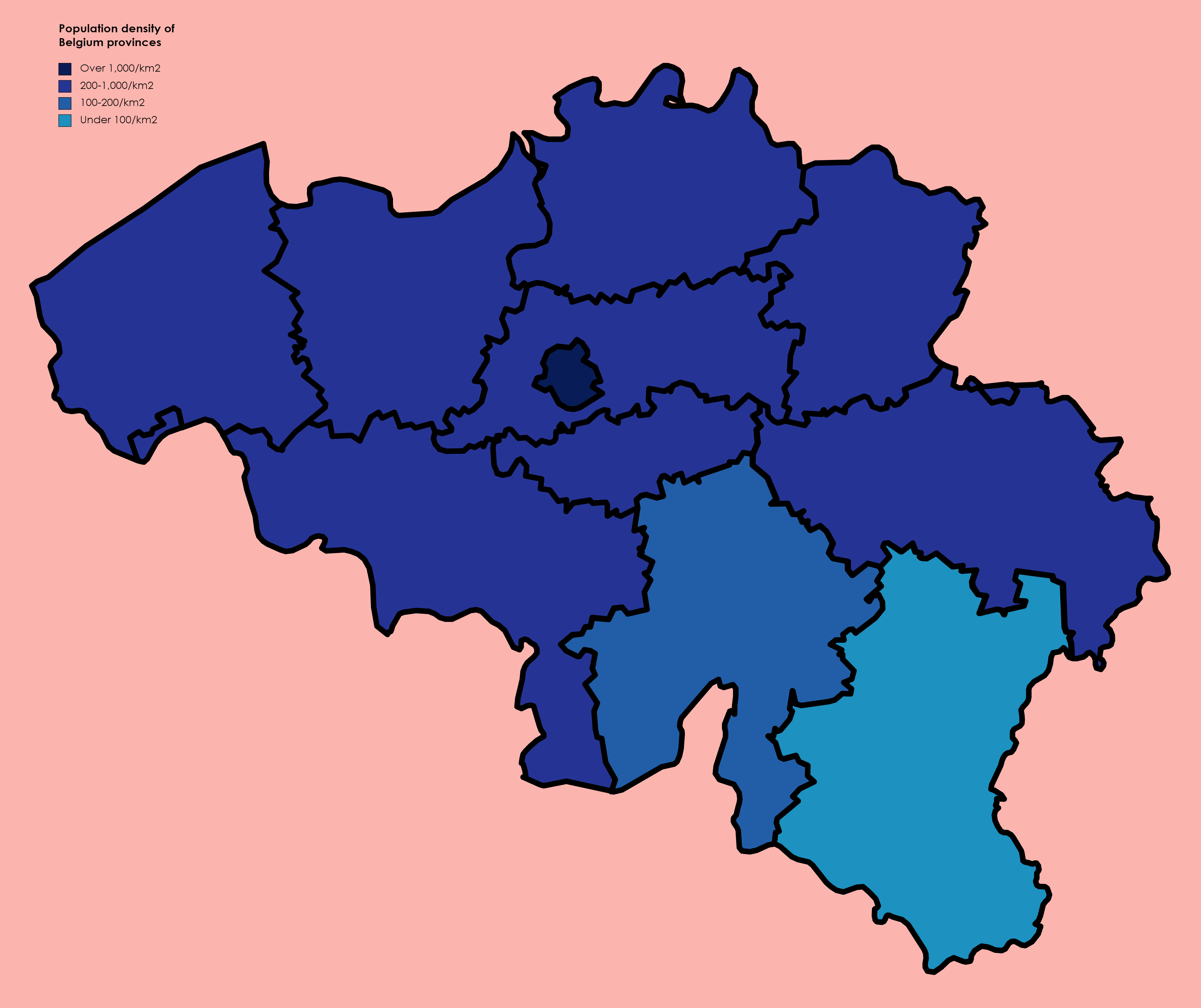|
List Of Belgian Provinces By GDP ...
This article lists Belgian provinces and regions ( NUTS 2) by gross domestic product (GDP). By GDP This table reports the gross domestic product (nominal GDP), expressed in billions of euro, of the ten provinces and the Brussels capital region in 2021. Flemish Region Walloon Region By GDP per capita This table reports the gross domestic product (adjusted for purchasing power parity), expressed in euro, of the ten provinces and the Brussels capital region in 2021. Flemish Region Walloon Region See also * List of Belgian provinces by Human Development Index References {{DEFAULTSORT:Belgian provinces by GDP Gross state product GDP Provinces by GDP Provinces by GDP Belgium Belgium, officially the Kingdom of Belgium, is a country in Northwestern Europe. Situated in a coastal lowland region known as the Low Countries, it is bordered by the Netherlands to the north, Germany to the east, Luxembourg to the southeas ... [...More Info...] [...Related Items...] OR: [Wikipedia] [Google] [Baidu] |
Provinces Of Belgium
The Kingdom of Belgium is divided into three Communities, regions, and language areas of Belgium, regions. Two of these regions, Flanders and Wallonia, are each subdivided into five provinces. The third region, Brussels, does not belong to any province, nor is it subdivided into provinces. Instead, it has amalgamated both regional and provincial functions into a single "Capital Region" administration. Most of the provinces take their name from earlier duchy, duchies and county, counties of similar location, while their territory is mostly based on the 130 departments of the First French Empire, departments installed during French annexation. At the time of the Independence of Belgium, creation of Belgium in 1830, only nine provinces existed, including the province of Brabant, which held the City of Brussels. In 1995, Brabant was split into three areas: Flemish Brabant, which became a part of the region of Flanders; Walloon Brabant, which became part of the region of Wallonia; an ... [...More Info...] [...Related Items...] OR: [Wikipedia] [Google] [Baidu] |
Nomenclature Of Territorial Units For Statistics
Nomenclature of Territorial Units for Statistics or NUTS () is a geocode standard for referencing the administrative divisions of countries for statistical purposes. The standard, adopted in 2003, is developed and regulated by the European Union, and thus only covers the EU member states in detail. The Nomenclature of Territorial Units for Statistics is instrumental in the European Union's Structural Funds and Cohesion Fund delivery mechanisms and for locating the area where goods and services subject to European public procurement legislation are to be delivered. For each EU member country, a hierarchy of three NUTS levels is established by Eurostat in agreement with each member state; the subdivisions in some levels do not necessarily correspond to administrative divisions within the country. A NUTS code begins with a two-letter code referencing the country, as abbreviated in the European Union's Interinstitutional Style Guide. The subdivision of the country is then refe ... [...More Info...] [...Related Items...] OR: [Wikipedia] [Google] [Baidu] |
Gross Domestic Product
Gross domestic product (GDP) is a monetary measure of the total market value of all the final goods and services produced and rendered in a specific time period by a country or countries. GDP is often used to measure the economic performance of a country or region. Several national and international economic organizations maintain definitions of GDP, such as the OECD and the International Monetary Fund. GDP is often used as a metric for international comparisons as well as a broad measure of economic progress. It is often considered to be the world's most powerful statistical indicator of national development and progress. The GDP can be divided by the total population to obtain the average GDP per capita. Total GDP can also be broken down into the contribution of each industry or sector of the economy. Nominal GDP is useful when comparing national economies on the international market according to the exchange rate. To compare economies over time inflation can be adjus ... [...More Info...] [...Related Items...] OR: [Wikipedia] [Google] [Baidu] |
Nominal GDP
Gross domestic product (GDP) is a monetary measure of the total market value of all the final goods and services produced and rendered in a specific time period by a country or countries. GDP is often used to measure the economic performance of a country or region. Several national and international economic organizations maintain definitions of GDP, such as the OECD and the International Monetary Fund. GDP is often used as a metric for international comparisons as well as a broad measure of economic progress. It is often considered to be the world's most powerful statistical indicator of national development and progress. The GDP can be divided by the total population to obtain the average GDP per capita. Total GDP can also be broken down into the contribution of each industry or sector of the economy. Nominal GDP is useful when comparing national economies on the international market according to the exchange rate. To compare economies over time inflation can be adjusted b ... [...More Info...] [...Related Items...] OR: [Wikipedia] [Google] [Baidu] |
Euro
The euro (currency symbol, symbol: euro sign, €; ISO 4217, currency code: EUR) is the official currency of 20 of the Member state of the European Union, member states of the European Union. This group of states is officially known as the euro area or, more commonly, the eurozone. The euro is divided into 100 1 euro cent coin, euro cents. The currency is also used officially by the institutions of the European Union, by International status and usage of the euro, four European microstates that are not EU members, the British Overseas Territory of Akrotiri and Dhekelia, as well as unilaterally by Montenegro and Kosovo. Outside Europe, a number of special territories of EU members also use the euro as their currency. The euro is used by 350 million people in Europe and additionally, over 200 million people worldwide use currencies pegged to the euro. It is the second-largest reserve currency as well as the second-most traded currency in the world after the United Sta ... [...More Info...] [...Related Items...] OR: [Wikipedia] [Google] [Baidu] |
Brussels
Brussels, officially the Brussels-Capital Region, (All text and all but one graphic show the English name as Brussels-Capital Region.) is a Communities, regions and language areas of Belgium#Regions, region of Belgium comprising #Municipalities, 19 municipalities, including the City of Brussels, which is the capital of Belgium. The Brussels-Capital Region is located in the central portion of the country. It is a part of both the French Community of Belgium and the Flemish Community, and is separate from the Flemish Region (Flanders), within which it forms an enclave, and the Walloon Region (Wallonia), located less than to the south. Brussels grew from a small rural settlement on the river Senne (river), Senne to become an important city-region in Europe. Since the end of the Second World War, it has been a major centre for international politics and home to numerous international organisations, politicians, Diplomacy, diplomats and civil servants. Brussels is the ''de facto' ... [...More Info...] [...Related Items...] OR: [Wikipedia] [Google] [Baidu] |
Purchasing Power Parity
Purchasing power parity (PPP) is a measure of the price of specific goods in different countries and is used to compare the absolute purchasing power of the countries' currency, currencies. PPP is effectively the ratio of the price of a market basket at one location divided by the price of the basket of goods at a different location. The PPP inflation and exchange rate may differ from the Exchange rate, market exchange rate because of tariffs, and other transaction costs. The purchasing power parity indicator can be used to compare economies regarding their gross domestic product (GDP), labour productivity and actual individual consumption, and in some cases to analyse price convergence and to compare the cost of living between places. The calculation of the PPP, according to the OECD, is made through a ''basket of goods'' that contains a "final product list [that] covers around 3,000 consumer goods and services, 30 occupations in government, 200 types of equipment goods and about ... [...More Info...] [...Related Items...] OR: [Wikipedia] [Google] [Baidu] |
List Of Belgian Provinces By Human Development Index
This is a list of Belgium, Belgian Provinces of Belgium, provinces and the Brussels, Region of Brussels by Human Development Index as of 2022. See also * List of Belgian provinces by GDP References {{Subnational entities by Human Development Index Economy of Belgium-related lists, Provinces by Human Development Index Human Development Index, Belgium Ranked lists of country subdivisions, Belgium, Human Development Index ... [...More Info...] [...Related Items...] OR: [Wikipedia] [Google] [Baidu] |
Gross State Product
Gross regional domestic product (GRDP), gross domestic product of region (GDPR), or gross state product (GSP) is a statistic that measures the size of a region's economy. It is the aggregate of gross value added (GVA) of all resident producer units in the region, and analogous to national gross domestic product. The GRDP includes regional estimates on the three major sectors including their sub-sectors, namely: * Raw material sector: Agriculture, animal husbandry, fishery, and forestry. * Industry sector: Construction, electricity, manufacturing, mining, quarrying, and water. * Service sector: Communication, finance, private government services, property management, real estate sales, storage, trade, and transport. "The GRDP is usually presented in nominal and real terms. Nominal GRDP measures the value of the outputs of the economy at current prices. Real GRDP referred to as GRDP at constant prices, measures the value of an economy's output using the prices of a fixed base ... [...More Info...] [...Related Items...] OR: [Wikipedia] [Google] [Baidu] |
Economy Of Belgium-related Lists
An economy is an area of the Production (economics), production, Distribution (economics), distribution and trade, as well as Consumption (economics), consumption of Goods (economics), goods and Service (economics), services. In general, it is defined as a social domain that emphasize the practices, discourses, and material expressions associated with the production, use, and management of resources. A given economy is a set of processes that involves its culture, values, education, technological evolution, history, social organization, political structure, legal systems, and natural resources as main factors. These factors give context, content, and set the conditions and parameters in which an economy functions. In other words, the economic domain is a social domain of interrelated human practices and transactions that does not stand alone. Economic agents can be individuals, businesses, organizations, or governments. Economic transactions occur when two groups or parties agr ... [...More Info...] [...Related Items...] OR: [Wikipedia] [Google] [Baidu] |
Lists Of Subdivisions Of Belgium
A list is a set of discrete items of information collected and set forth in some format for utility, entertainment, or other purposes. A list may be memorialized in any number of ways, including existing only in the mind of the list-maker, but lists are frequently written down on paper, or maintained electronically. Lists are "most frequently a tool", and "one does not ''read'' but only ''uses'' a list: one looks up the relevant information in it, but usually does not need to deal with it as a whole".Lucie Doležalová,The Potential and Limitations of Studying Lists, in Lucie Doležalová, ed., ''The Charm of a List: From the Sumerians to Computerised Data Processing'' (2009). Purpose It has been observed that, with a few exceptions, "the scholarship on lists remains fragmented". David Wallechinsky, a co-author of '' The Book of Lists'', described the attraction of lists as being "because we live in an era of overstimulation, especially in terms of information, and lists help us ... [...More Info...] [...Related Items...] OR: [Wikipedia] [Google] [Baidu] |







